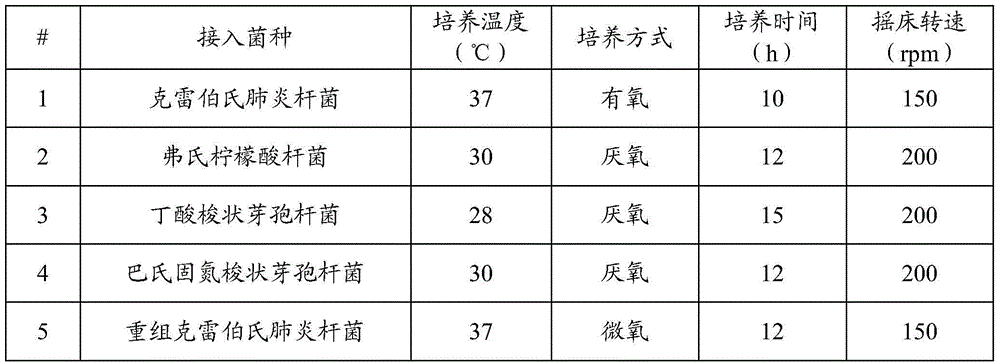Method for manufacturing 3-hydroxypropionic acid from microbial fermentation glycerol
A technology of microbial fermentation and hydroxypropionic acid, applied in the field of microbial fermentation and bioengineering, can solve the problems of no glycerol dehydratase enzyme activity, increase the difficulty of operation, and it is difficult to completely cut off the production path, so as to avoid energy consumption and rate limitation. , The effect of eliminating the steps of gene manipulation and good industrial application prospects
- Summary
- Abstract
- Description
- Claims
- Application Information
AI Technical Summary
Problems solved by technology
Method used
Image
Examples
Embodiment 1
[0032] Example 1 , Construction of Klebsiella pneumoniae (K.pneumoniae) glycerol dehydratase enhanced strain
[0033] The gene dhaB (GenBank accession No.U30903) encoding glycerol dehydratase was amplified from Klebsiella pneumoniae by PCR technology, and it was connected to the expression vector pKM13 (Ping Zheng, Kirsten Wereath, etc., Process Biochemistry 41 (2006) 2160–2169), the recombinant plasmid pKM13-dhaB was obtained, and the recombinant plasmid was transformed into Klebsiella pneumoniae ATCC25955 to obtain the recombinant strain ATCC25955 / pKM13-dhaB.
[0034] The specific construction process is:
[0035] (1) Construction of expression plasmids:
[0036] According to Klebsiella pneumoniae dhaT gene sequence design two primers, its sequence is as follows:
[0037] Primer 1: 5'-ccg gaattc atgaaaagatcaaaacgatttgc-3'
[0038] Primer 2: 5'-tgc tctaga ttaattcgcctgaccggccag-3'
[0039] Klebsiella pneumoniae genomic DNA was used as a template to amplify the target ...
Embodiment 2
[0045] Example 2 , Construction of Gluconobacter oxydans (G.oxydans) Alcohol Dehydrogenase Enhanced Strain
[0046] The gene adhAB encoding membrane-bound alcohol dehydratase was amplified from Gluconobacter oxydans DSM2003 by PCR technology, and was connected to the expression vector pBBR1MCS-5 with DNA ligase to obtain the recombinant plasmid pBBR1MCS-5-adhAB, which was transformed into Gluconobacter DSM2003 was oxidized to obtain the recombinant strain DSM2003 / pBBR1MCS-5-adhAB.
[0047] The specific construction process is:
[0048] (1) Construction of expression plasmids:
[0049] Two primers were designed according to the gene sequence of Gluconobacter oxydans alcohol dehydrogenase (G.oxydans 621H GGOX1068), the sequences of which are as follows:
[0050] Primer 1: 5'-AAA GTC GAC ATGAACGACACGGTGCCCGAGC-3'
[0051] Primer 2: 5'-TC TCTAGA CAGGGGTGGGGACGCTTATTGTGCG-3'
[0052] Genomic DNA of Gluconobacter oxydans DSM2003 was used as a template to amplify the target...
Embodiment 3
[0058] Example 3 , A seed culture of microorganisms
[0059] Seed medium formula (g / L): peptone 10, yeast powder 5, NaCl 10, glycerol 2, adjust the pH to 7.0 with 2mol / L KOH, and sterilize at 121°C for 20 minutes.
[0060] Take a 250ml triangular flask, and fill the seed medium with 50ml of liquid. According to Table 1, use an inoculation loop to inoculate one ring of strains preserved on a slant. The culture temperature is 28-37°C. Oxygen cultivation was carried out for 10-15 hours, and the rotation speed of the shaker was 150-200 r / min.
[0061] Described strain is: Klebsiella pneumoniae (Klebsiella pneumoniae) ATCC25955, freund's Citrobacter freundii (Citrobacter freundii) DSM30040, butyric acid Clostridium (Clostridia butyricum) DSM5431, Pasteurian nitrogen-fixing Clostridium (Clostridia pastruianu) DSM525.
[0062] Table 1. Microbial seed culture conditions
[0063]
PUM
 Login to View More
Login to View More Abstract
Description
Claims
Application Information
 Login to View More
Login to View More - R&D
- Intellectual Property
- Life Sciences
- Materials
- Tech Scout
- Unparalleled Data Quality
- Higher Quality Content
- 60% Fewer Hallucinations
Browse by: Latest US Patents, China's latest patents, Technical Efficacy Thesaurus, Application Domain, Technology Topic, Popular Technical Reports.
© 2025 PatSnap. All rights reserved.Legal|Privacy policy|Modern Slavery Act Transparency Statement|Sitemap|About US| Contact US: help@patsnap.com



